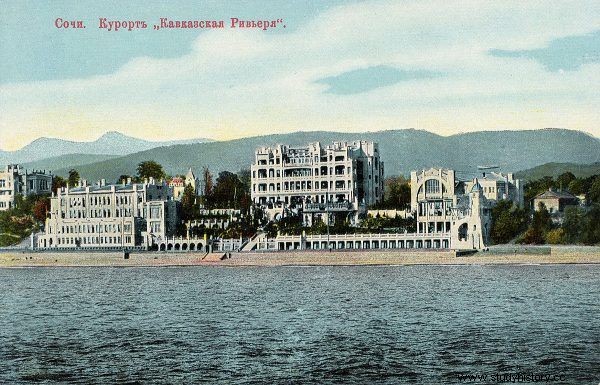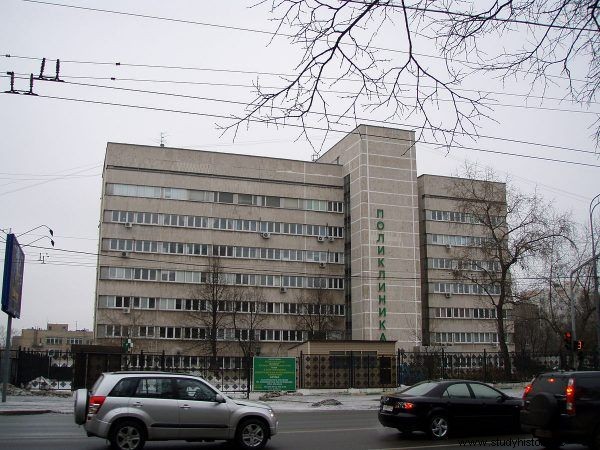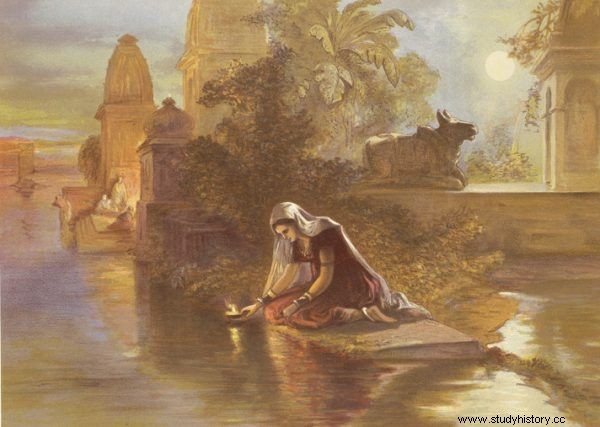Constant fear, humiliation and endless series of catastrophes. The youth of this Soviet heiress did not resemble a fairy tale at all. In the end, however, she also met her prince ... Only that a ruthless communist system stood on the way to a happy ending.
Three weddings and a funeral
Before Svetlana, the only daughter of Joseph Stalin, met her "prince charming", she had already had three unsuccessful marriages. Her first love was Grigory Morozov, whom the despotic father did not like at all. Despite objections, she married him in 1944. However, the couple divorced after three years. From this marriage, Svetlana's first child, Józef, was born.

The knight Dobrynia saves the beautiful princess Zabawa from the ugly dragon paws, but he cannot marry her. This Old Russian fairy tale is reminiscent of the story of the most famous Soviet princess. Illustration by Ivan Bilibin (public domain).
The next marriage of the Kremlin princess was concluded in accordance with the wishes of Stalin. In 1949, she married Yuri Zhdanov. Already during the honeymoon it was obvious that this marriage would also be unsuccessful. The leave turned out badly. Svetlana loved water, and he contracted seasickness. He loved the mountains, she was afraid of heights - we read in Rosemary Sullivan's book, "Stalin's Daughter". The divorce took place in 1951, and the only "memento" of the relationship was little Katia.
Still looking for true love, Svetlana got into more affairs. However, she married for the third time only after her father's death, in 1962. In order to avoid the burden of the family surname that was weighing on her more and more, she was already using her mother's maiden name - Alliłuyev. This time her chosen one was a victim of her father's criminal policy. Ivan Swanidze was related to Svetlana. His parents were murdered by the dictator in the 1940s. He himself was raised in an orphanage for the children of political prisoners, and then at the age of 17 he was sent to a mine in Kazakhstan. The marriage only lasted a year.
You will meet a not very handsome brunet
Soon after, an extraordinary story happened to Svetlana in Leningrad. She met Professor Wiktor Manujłow, an avid bibliophile and expert on Russian poetry. The one, clearly interested in Svetlana, offered her reading by hand. When the woman opened her hand to him, she heard the prophetic words:
Your life is divided into three periods. The first is over a long time ago. It was a time of darkness and sorrow. Now you are going through a difficult period. With all your strength you are looking for a prince from a faraway land who will… fall sick and die. Then you will enter the third period, in which you will reach far lands across the ocean.
The "prince from a distant land" announced by the professor entered the scene soon. Love came to Svetlana in the most unexpected place. She met her lover ... in the hospital corridor.
It was October 1963. She - shortly after tonsillectomy, he - after removing polyps from the nose. Raja Brajesh Singh, in a bathrobe and cotton wool in her nostrils, turned out to be the love of her life . A communist from India flew to the Soviet Union to heal his endless health problems.

Svetlana, despite three marriages, did not find true love for life and death. In the photo, the beautiful daughter of Stalin in 1954, while searching for husband number three. The photo comes from the promotional materials of Rosemary Sullivan's book "Stalin's Daughter", published by Znak Horyzont (photo:EAST NEWS / SPUTNIK).
He was not the only foreigner to use the services of Soviet medics. After the Khrushchev thaw, citizens of countries outside the Eastern Bloc could come to the USSR. The only condition was a "strong bond" linking them with the prevailing ideology in this country. Singh was indeed an advocate of social equality. He was less impressed with the idea of class struggle. He repeated many times that for a great idea, he would not even hurt a fly. This attitude must have impressed the tyrant's daughter.
At first, Brajesh and Svetlana passed each other in the hospital corridor without words. Curiosity, however, won out in the end, and the Soviet princess engaged a conversation. She knew English perfectly well and was quite well versed in current affairs in India, so the couple found common topics without any difficulty. From then on, they spent every free moment with each other. They walked along the corridor of the hospital and… focused on themselves envious glances of Soviet apparatchiks. There was still no climate in Moscow, neither for health, nor for such open flaunting with foreigners .

The romance of the Soviet princess and her prince from a distant land unfolded in the fairy-tale scenery of the Caucasian riviera. The postcard shows a resort in Sochi at the beginning of the 20th century (source:Granbergs Konstindustri Aktiebolags Förlag, public domain).
Fate wished the doctors recommended both of them to be treated in a warmer climate. In November 1963, Stalin's daughter and the Indian Rajah went to Sochi. They were lucky because at that time it was difficult to find Moscow notables there. The anniversary of the 1917 revolution was finally approaching.
However, it would be naive to believe that the couple will be left on their own. When they stayed together in one room, they had to take into account the constant visits of the centre's employees. And it was necessary at this point that they had to replace the bedding, and this was to clean up or at least bring fresh fruit. Besides, the Kremlin tops were kept informed about the behavior of Svetlana. "Friendly" Soviet dignitaries suggested that she only deal with "her own".
There will be no wedding
After staying in Sochi, Singh had to return to India, but he promised his beloved that he would come to her in Moscow. However, the lovers had to wait a bit for the meeting. It didn't happen until 1965, after a year and a half of battles with the Soviet bureaucratic machine. Singh, who wanted to work in a publishing house as a translator, like any foreigner, had to wait for a special invitation from his employer. Throughout this period, the couple corresponded with each other, although the letters very often did not reach the addressees.
Finally the rajah came to Moscow. Unfortunately, his health had deteriorated significantly in the meantime. He himself even suggested that it was not worth the trouble of because these could be his last years of life ... But Svetlana didn't even want to hear about it.

When Svetlana managed to convince her prince to marry, it seemed that nothing would stand in the way of their happiness. The unexpected "wizard" who stopped the wedding bells was ... the Prime Minister of the USSR, Alexei Kosygin. In the photo on the left, during a conversation with US President Lyndon B. Johnson in 1967 (photo:Yoichi Okamoto - LBJ Library, public domain).
Reunited after a long break, the lovers were going to get married. They filed the necessary documents with the registry office, disregarding the fact that… Brajesh was still formally married! But there was no feeling whatsoever attached to him. And, most importantly, his current relationship was purely religious, and therefore - according to USSR law - was invalid. There was no need to wait for a divorce. But the "facilitations" ended there, because as soon as the documents were in office, the Prime Minister of the USSR, Alexei Kosygin, called Stalin's daughter. He absolutely wanted to see her.
As we read in the book "Stalin's Daughter", after many years of break, Svetlana once again visited the well-known buildings of the Kremlin. In the days of Khrushchev, she was given relative peace. However, from 1964, power in the USSR was exercised by Leonid Brezhnev, which set a different tone for the country's domestic politics.
As we learn from Alliluyeva's memoirs, the atmosphere in Kosygin's office was very unpleasant. He urged Svetlana to return to the collective and engage in party activities. After all, she was the daughter of Stalin himself! She had no intention of doing so, dodging the need to care for her children and her new husband. When Kosygin heard this he allowed himself an indiscriminate comment:
And what did you guys do for us here? You, a healthy young woman, a sportswoman! You really couldn't find someone on the spot? Someone younger? Strong? What are you going to do with this infirm old Indian comrade? Not! We are firmly against such actions! Definitely!
Svetlana understood that there would be no wedding.
"Holidays, I know I'm going to die today"
Despite the obstacles in their way, the feeling between Alliluyeva and Singh deepened. They found support and understanding within themselves. In him, she admired his positive disposition and joy in every day - feelings so alien to Soviet reality. He valued her intelligence and independence. Svetlana's children also accepted her new "husband". They noticed that their mother seemed happy after all.

Brajesh's health soon deteriorated so much that he was sent to the Polyclinic for Foreigners, and then to the hospital in Kuncewo. In this contemporary photo, a polyclinic in Moscow (photo:Digr, license CC BY-SA 3.0).
Unfortunately, Brajesh's health continued to deteriorate. First, he was taken to the Polyclinic for Foreigners, where he was misdiagnosed with tuberculosis. Then he was taken to hospital in Kuncewo. Svetlana spent days with him. They both realized that they had very few moments together.
Singh wanted to go back to India. Wanting to accompany him, Alliluyeva wrote letters to Brezhnev asking for permission to travel to her beloved's homeland. Nothing of that! The place of Stalin's daughter is in the homeland, and if the Indian wants to come back, let him come back alone Was the answer.

Svetlana personally made sure that the ashes of her prince charming found eternal rest in the current of the Ganges. She made her first trip abroad with the urn. Pictured is a painting by William Simpson from 1867 (public domain).
In the end, the ailing Prince Charming returned home from the hospital at his own request. On October 30, 1966, he admitted to his beloved that he dreamed of a white ox pulling a cart. In Hindu culture, such a dream can herald only one thing - imminent death. The prophecy came true the very next day.
Last farewell in India
Alliluyeva quickly informed Singh's Hindu friends to take the body to the crematorium. She did not want Soviet apparatchiks to get to him. A modest and intimate funeral ceremony took place on November 1. The urn with the ashes was given to Svetlana. Now her main goal was to fly to India. She intended, as requested by the deceased, to scatter his ashes over the waters of the Ganges.
This time Kosygin allowed the departure. However, it is difficult to find good will in this gesture. It was political pressure . Singh's nephew, Dinesh, intervened with Indira Gandhi herself, then Prime Minister of India. Svetlana was allowed to go on condition that the authorities in Brajesh's homeland did not allow any journalists to visit her.

Although life with the Prince Charming did not last long, almost as if by the touch of a magic wand he changed the entire life of Saint. If it weren't for him, she would never have ended up at Kennedy Airport in New York where this photo was taken. The photo comes from the promotional materials of Rosemary Sullivan's book "Stalin's Daughter" (photo:AP Photo).
On December 20, 1966, a grieving woman landed in New Delhi. Her passport, visa and plane ticket were confiscated. She was accommodated in an ascetic room with only a bed and a table. She was only allowed to make phone calls in the embassy building, assisted by clerks. In addition, her personal "guardian", Mrs. Kassirova, an employee of the Soviet Ministry of Foreign Affairs, was appointed to follow Stalin's daughter step by step.
On December 25, Svetlana flew to Lucknow. From there, by car, she went to Singha's hometown of Kalankary. Of course, she was accompanied by Mrs. Kassirowa, and also by Dinesh's daughter, Reva. When they got there, their brother took in. It was he who led the procession and carried the urn with the ashes to finally sink it into the Ganges stream. The will of the beloved Kremlin princess has been fulfilled.
***
Paradoxically, the tragic love for the Hindu Rajah gave Svetlana the only chance to break free from the hands of the communist authorities. Taking advantage of the opportunity and the alcohol-obscured inattention of Soviet officials, fled to the American embassy and asked for political asylum .
The daughter of the dictator, whose portraits hung in a row with Marx, Engels and Lenin, fled to the USA - the greatest enemy of the Soviet Union. Was she happy there? Doubtful. After all, throughout her life, wherever she appeared, everyone saw in her first Stalin's daughter, and only then herself - Svetlana Alliluyeva. The only exception was Brajesh Singh, her prince from a far country .
